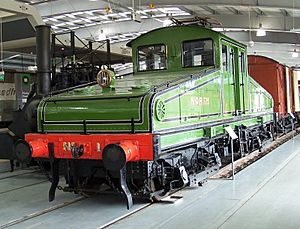British Rail Class ES1 facts for kids
Quick facts for kids North Eastern Railways Class ES1 |
|
 |
|
| NER No.1, Locomotion museum, Shildon | |
| Power type | Electric |
|---|---|
| Builder | British Thomson-Houston, with mechanical parts sub-contracted to Brush, for North Eastern Railway |
| Build date | 1903-1904 (contract signed with builders on 15 December 1902) |
| Total production | 2 |
| Configuration | Bo+Bo |
| Gauge | 4 ft 8 1⁄2 in (1,435 mm) |
| Wheel diameter | 3 ft 0 in (0.914 m) |
| Wheelbase | 27 ft 0 in (8.230 m) |
| Length | 37 ft 11 in (11.557 m) |
| Height | with pantograph lowered 12 ft 11 in (3.937 m); raised 15 ft 9 in (4.801 m) |
| Locomotive weight | 56 tons (51 tonnes) |
| Electric system(s) | 600–630 V DC |
| Current collection method | Third rail or pantograph |
| Traction motors | British Thomson-Houston, 4 off |
| Top speed | 27 mph (43 km/h) |
| Power output | 640 hp (477 kW) |
| Tractive effort | 25,000 lbf (111.2 kN) |
| Train heating | None |
| Career | North Eastern Railway London and North Eastern Railway British Railways |
| Number | NER: 1–2 LNER 1–2, later 6480–6481 BR: 26500–26501 |
| Axle load class | Route availability 2 |
| First run | 1905 |
| Retired | 1964 |
| Disposition | No.1 preserved, No.2 scrapped in 1966 |
The British Rail Class ES1 was a type of electric locomotive. Only two of these powerful engines were ever built. They were ordered by the North Eastern Railway in 1902. These locomotives had a special shape called a "steeplecab" design. This means the main part of the engine was tall and narrow, like a church steeple.
What Was the ES1?
The ES1 locomotives were designed to pull trains using electricity. They were among the very first electric locomotives used in Britain. Their job was to move heavy coal trains. They worked on a special railway line near Newcastle upon Tyne.
How the ES1 Worked
The ES1 locomotives got their power from electricity. They used 600 to 630 volts of DC electricity. This power could be picked up in two ways. One way was through a "third rail" system. This is an extra rail next to the main tracks that carries electricity. The other way was using a pantograph. A pantograph is an arm on the roof that touches overhead electric wires.
The ES1 had four powerful motors. These motors gave the locomotive about 640 horsepower. This was enough to pull heavy loads. The top speed of an ES1 locomotive was around 27 miles per hour. This speed was good for moving slow, heavy freight trains.
A Short History
The two ES1 locomotives were built between 1903 and 1904. The main builder was British Thomson-Houston. Another company, Brush Traction, helped build the mechanical parts. The first ES1 started running in 1905.
These locomotives served different railway companies over the years. They started with the North Eastern Railway. Later, they became part of the London and North Eastern Railway. Finally, they were used by British Railways.
The ES1 locomotives worked for many years. They were retired from service in 1964. One of the two locomotives, named No. 1, was saved. You can see it today at the Locomotion museum in Shildon. The other locomotive, No. 2, was taken apart in 1966.
Images for kids
-
As built, with the original bow collector



